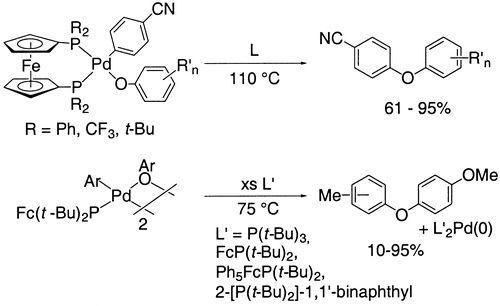Electronic and Steric Effects on the Reductive Elimination of Diaryl Ethers from Palladium(II)
Organometallics, 2003, 22 (2775-2789)
View on publisher site
Abstract
Arylpalladium aryloxide complexes containing sterically and electronically varied phosphine ligands were prepared, and the rates for reductive elimination of diaryl ethers from these complexes were studied to determine the ligand properties that most strongly accelerate this unusual reaction. Electronic and steric effects were probed by preparing monomeric palladium complexes of the type (L)Pd(Ar)(OAr‘), in which L = DPPF (1,1‘-bis-diphenylphosphinoferrocene), CF3-DPPF (1,1‘-bis[di(4-(trifluoromethyl)phenyl)phosphino]ferrocene), and D-t-BPF (1,1‘-bis(di-tert-butylphosphino)ferrocene) and Ar = electron-deficient and electron-neutral aryl groups. Direct C−O bond-forming reductive elimination to form diaryl ethers in high yield was observed after warming the complexes that contained an electron-deficient aryl group bound to palladium. The rate constant for C−O bond-forming reductive elimination from the CF3-DPPF-ligated palladium complex was twice that obtained for the analogous DPPF-ligated complex. Reductive elimination of diaryl ether from the more bulky D-t-BPF complex occurred roughly 100 times faster than from the DPPF complex. Thermolysis of DPPF and CF3-DPPF complexes containing an electron-neutral aryl group did not form diaryl ether. Thermolysis of (D-t-BPF)Pd(Ph)(OC6H4-4-OMe) also did not form diaryl ether and generated the two monophosphines PhP(t-Bu)2 and FcP(t-Bu)2 (di-tert-butylphosphinoferrocene). However, heating of a FcP(t-Bu)2-ligated aryloxide complex containing an electron-neutral, palladium-bound aryl group generated diaryl ether in 10−25% yield. Moreover, heating of this complex in the presence of an excess of P(t-Bu)3 or Ph5FcP(t-Bu)2 or 1 equiv of 2-di-tert-butylphosphino-1,1‘-binaphthyl generated diaryl ether in higher, 58−95%, yields. The effect of ligand concentrations on reaction yields implied that exchange of the bulkier ligands with FcP(t-Bu)2 induced the reductive elimination of diaryl ether.
Read on publisher's site